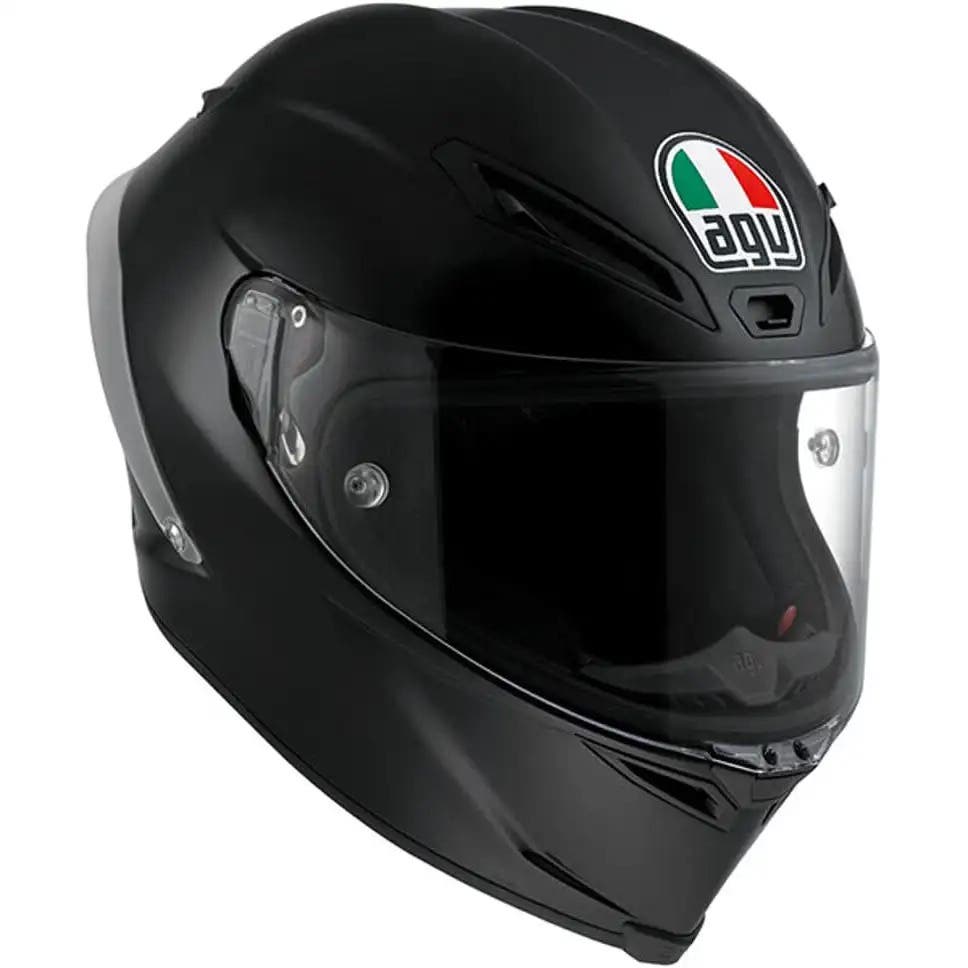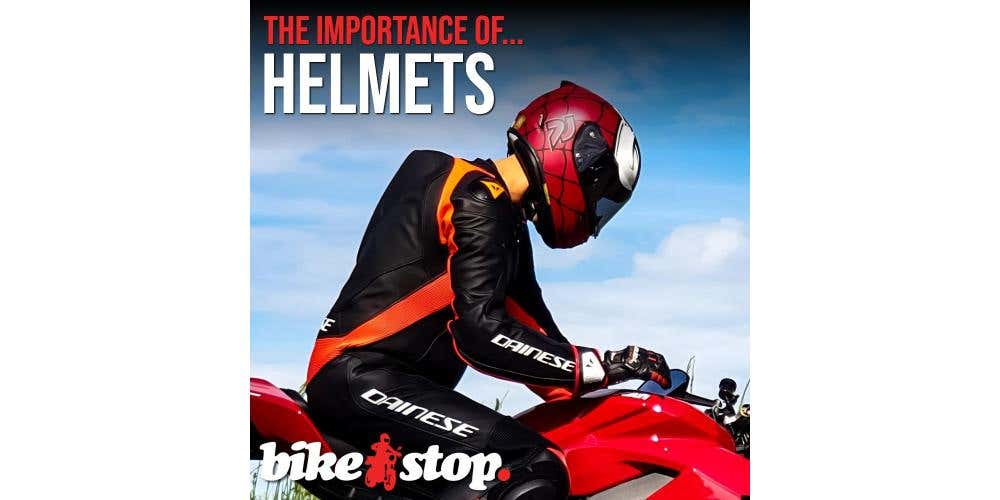In part of three of our "importance of..." series, we're talking about helmets. When it comes to safety, the helmet stands alone. Not only is it the single item of motorcycle gear mandated by law, it's the piece of kit which protects your head, brain, spine and face. Now, I'm not the prettiest or smartest guy in the world, but I'd like to keep my face attached to my head and my brain capable of performing simple tasks. Helmets are also one of the most complex items of gear. Multiple layers of different materials, each perform a specification function to keep your head safe, working to mitigate against the effects of impact, compression, abrasion, and friction. It has to all of that while remaining comfortable for hours on end, providing ventilation, and looking awesome.
Why do I need a helmet?
The Law: There are many reasons you need a helmet. Firstly, and most importantly, it's a legal requirement. The use of a motorcycle helmet while riding a motorcycle in the UK is mandated by law under Section 16 of the Road Traffic Act 1988. The law requires that any person who is riding a motorcycle (or a moped) on a public road must wear a helmet. Additionally, the helmet must be securely fastened and fitted properly to ensure maximum protection and meet current safety standards (ECE22.06). Failing to comply with this law can result in a fine and points on your licence. The only exception is for Sikhs who choose to wear a turban, but aside from that, you must wear one.
Protection from Head Injuries: This should be obvious, but we'll cover it anyway. The primary function of a helmet is to protect the rider's head from injury in the event of an accident or collision. A helmet can prevent or reduce the severity of head injuries such as skull fractures, traumatic brain injury, and concussions, which can be fatal or cause permanent damage.
Elemental Protection: A helmet provides protection from external elements such as wind, rain, and dust, which can be distracting or harmful to the rider. Additionally. a clear visor or clear lenses in goggles also improve visibility, especially during adverse weather conditions. If you've ever tried to ride in heavy rain with your visor open, you'll know a stray raindrop can feel like a bullet when you're travelling at speed. Furthermore, small particles of dust or sand can be particularly unpleasant.
Improved Visibility: Perhaps not an obvious one, but bright or reflective colours - white and fluo yellow, for example, can make the rider more visible to other drivers on the road, reducing the risk of accidents.
What if I don't wear one?
Aside from the fact you'll be breaking the law, there's a range of unpleasant potential outcomes should you inadvertently find yourself tumbling away from your bike. First and foremost are head and brain injuries. Without a helmet, the rider's skull and brain are exposed to impact and abrasion, which can result in traumatic brain injury, skull fracture, and concussion. Even if your brain survives, there's no guarantee your face will. There's a whole list of lacerations, fractures and dental injuries to stop you from looking pretty in the event of an off. However, it's not just accidents. Your face would be exposed to lots of things you don't want to connect with at speed. You wouldn't want to take a bumblebee to the face at 70mph, that's for sure.
Your helmet also helps to protect against neck and spinal injuries. In a crash, the sudden jolt and impact can cause the head to jerk forward or backwards, which can result in neck and spinal injuries such as whiplash, vertebral fractures, or even paralysis. If that's not enough, you need to consider what happens to a skin-wrapped skull should it be exposed to the unforgiving surface of the road. Think about what would happen if you attacked a watermelon with an angle grinder, for example.
Of course, the worst outcome is death, and that's not unlikely, either. While our bodies are rough, tough machines, they have their limits, and it doesn't take much force to stop permanently stop them working.
As with all motorcycle gear, there are no guarantees. There's no such thing as 100% protection to keep you safe in all scenarios. The point of our protective equipment is to mitigate possible damage. It gives you a fighting chance of survival.
Materials
A motorcycle helmet's shell is the outer layer and can be made from different materials, each with its own properties and characteristics that affect its weight, strength, durability, and cost. You don't necessarily need to go out and spend thousands on the latest all-carbon affair from a premium brand, but you should be aware of the the different materials available.
Polycarbonate (or thermoplastic)
This is the most common material used for budget-friendly helmets. Polycarbonate is a type of thermoplastic that is lightweight, impact-resistant, and flexible.
Polycarbonate tends to be more prone to abrasion, and thus you need more of it. This typically results in polycarbonate helmets weighing more than helmets constructed from more exotic materials.
Fibreglass
Fibreglass is a blend of glass fibres and resin combined to create a shell that's stiff, lightweight and strong.
On the whole, fibreglass is stronger than polycarbonate but also more flexible. The extra flexibility works better for impact absorption but means there's almost always more EPS foam to help with dissipating the force of impacts.
Multicomposite (or composite)
Multicomposite helmet shells are formed by layers of different materials combining to provide the best of all worlds. Bringing together materials such as carbon fibre, aramids and fibreglass, a good multicomposite helmet will protect against both abrasion and impact in equal measure and suited for many different types and styles of riding with relatively little weight.
Carbon Fibre
Carbon fibre tends to be used on the sportier, more extreme end of the helmet spectrum. Typically backed with an aramid such a Kevlar, a carbon fibre shell is lightweight and handles impacts well.
Tends to be the most expensive option but not necessarily the best at dealing with abrasion, where cheaper materials may fare better.
EPS Foam: Undeath the shell is a layer of EPS foam (expanded polystyrene foam). The EPS foam layer in a motorcycle helmet is designed to absorb and dissipate the energy from an impact, helping to reduce the amount of force that is transmitted to the rider's head. When a helmet is subject to impact, the foam compresses and deforms, absorbing the energy so that your skull doesn't have to. It also helps to spread the force of the impact over a larger area, which again helps reduce the risk of injury.
The EPS foam in a motorcycle helmet is designed to be a one-time use material. In other words, once the foam has compressed and deformed in response to an impact, it will not provide the same level of protection in a subsequent impact. This is why it's important to replace a helmet after an accident or even if it has been dropped. It's important to remember that the foam can be damaged even if there is no visible damage to the helmet's exterior. Additionally, not all EPS foam is created equal. Different helmets can use different densities or thicknesses of EPS foam, which can affect the level of protection that the helmet provides.
Types of Helmet
As with boots, gloves, jackets and everything else to do with motorcycling, different types and styles suit different riders. No matter whether you're commuting on a moped, doing trackdays, or riding through sand and mud, there's something for everyone.
Full-Face
Probably the most common type of helmet you'll see. These helmets provide the most comprehensive protection, covering the entire head, face, and chin. They are popular among sports and high-speed riders, as they offer superior impact resistance, noise reduction, and aerodynamics.


Open-Face
Also known as three-quarter helmets, these helmets cover the head and ears but expose the face and chin. They are popular among cruisers and vintage riders, as they offer a classic, stylish look and better ventilation. However, ventilation comes at a cost, and without chin and face protection, you might want to consider other options.


Modular
These helmets are a hybrid of full-face and open-face helmets, as they feature a chin bar that can be flipped up or removed, providing versatility and convenience. Modular helmets are suitable for touring and commuting, as they offer good protection, comfort, and visibility. Due to their construction, they tend to be heavier than full-face helmets, but the option is there should you need it.


Half
These helmets cover only the top of the head and offer minimal protection, primarily against impacts and abrasions. They are popular among riders who prefer a minimalistic, lightweight design and maximum freedom of movement. However, unless you have a very specific need for a half helmet, there are significantly safer options in the rest of this list.


Off-Road
Also known as motocross or MX helmets. These helmets are designed for dirt and adventure riders, as they offer maximum ventilation, impact resistance, and peripheral vision. They feature a peak to protect the eyes from dust, mud, and sun glare. Almost always used with goggles, which you'll have to buy separately.


Dual-Sport
These helmets combine the features of full-face and off-road helmets, providing a balance between protection and versatility. They are suitable for riders who switch between on-road and off-road terrain. They can be used with either a visor or goggles and feature a peak to help block out the sun. Very popular with adventure bike riders who dabble with a bit of off-road stuff.


What should I buy?
When choosing a motorcycle helmet, there are several features that you should look for to ensure maximum comfort, safety, and performance. However, arguably the most important factor is fit. Many people ride around with a helmet which is too tight or, more commonly, too loose. If your helmet is too tight it'll be horribly uncomfortable and become worse over the duration of your ride. If your helmet is too loose, it'll pop off your head in an instant should the worst happen and be of no value whatsoever. Whether you've never bought a helmet before or you've bought hundreds over previous decades: always try on a helmet before you buy. When you're trying it on, keep it on your head for at least 10 minutes and preferably longer.
Aside from fit, there are a few other considerations to take into account when you're buying a new lid.
Ventilation: An unventilated helmet on a hot day is going to be like a minature oven for your head. Make sure your new lid has good ventilation. Typically, you'll find a vent on the chin as well as vents for the top of your head. Keeping cool is a good thing, but make sure to close up those top vents in less desirable weather.
Visor: The visor should provide clear vision and protection from glare, wind, and debris. Look for helmets with anti-fog, anti-scratch, and UV-protective visors. While some helmets come with a couple of visors, many don't, but you can almost always buy tinted - or even photochromatic - visors for your helmet.
Padding and Liner: The interior of the helmet should have comfortable, moisture-wicking padding and a removable, washable liner to improve comfort and hygiene. It may not sound like a big deal with a comfortable, well-padded liner can make the world of difference when it comes to comfort. Furthermore, if the lining material is terrible at wicking, there's a strong chance your helmet will end up smelling like a burning zoo.
Weight: The helmet should be lightweight enough to minimize neck strain and fatigue, without compromising safety. Typically the more money you pay, the lighter the materials and the lighter the helmet. It's an important factor to take into consideration when trying on new helmets. It may not sound much but you'll certainly feel the weight of a 2kg lid after a while.
Style and Design: There's a style and design for everyone. You may want a plain white one or you may want to look like Rossi or Marquez. Look for helmets that match your style and personality, but prioritise safety and performance over aesthetics.
Additional Features: Some helmets may have additional features such as Bluetooth connectivity, integrated sun visors, or reflective materials. These features can improve convenience and visibility but may increase the cost.
Finally, two more important points to take into consideration.
Avoid Fakes: Believe it not, fake motorcycle helmets are big business. Buy from a reputable supplier. Don't be convinced to hand over money to a no-name trader online or at a motorcycle show. If something seems too cheap, it's probably for a reason. I'm sure you don't want a helmet with the structural rigidity of a Rice Krispie.
Age: A helmet has an approximate life of around five years of use or seven years from the date of manufacture. If your helmet is getting on a bit, maybe it's time to think of a replacement?
As always, the team at Bike Stop will be more than happy to guide you through your helmet purchase and make sure you get a genuine, safe helmet that fits properly and is comfortable to wear.






